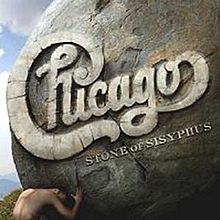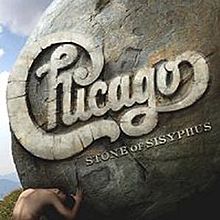Sisyphus believed he could tackle that rock one more time … and that’s the kind of faith you have to have in yourself and your work. — Dawayne Bailey
I love that quote. So shirt worthy!
Previously, On Allison’s Written Words…
Chicago’s second era played around with the 80s Adult Contemporary and Power Ballad era, notable for two very different eras within the band – the Peter Cetera era (or Cet-era) (Chicago 17) and the post-Cetera era (Chicago 18, 19, andTwenty 1). As the years progressed, the group relied heavily on outside writers for many of their hits, and this wore the band down a bit. Further changes yielded new vocal talent, increased focus on certain members, and the eventually, a change in music style and taste. Chicago had enjoyed a renewed career, and once again, they were going to have to re-invent the wheel.
After the release of Twenty 1, Chicago had a “Best Of” album, received a star on the Hollywood Walk of Fame, and went back into the studio to prepare their twenty-second studio album. Little did they know that the title they would choose would become as legendary as the album itself.
1993

Stone of Sisyphus (originally numbered Chicago XXII: Stone of Sisyphus, now considered XXXII), is the twenty-first studio album (and 32nd overall) for Chicago, originally set to be released on March 22, 1994. The group’s effort was to be a return to their roots on a personal, musical, and cultural level. The goal was “commercially-marketable trappings,” but instead, according to Jason Scheff, “the beginning of that spirit…of making music for the right reasons.”
With producer Peter Wolf at the helm, the group set to work recording an album that was to be everything the last ten years’ worth of music was not. Out were the power ballads that dominated the group’s second era. In were experimental pieces that allowed the group to re-invent and re-invigorate. It was all supposed to be amazing, a beautiful turn of events that was going to make Chicago a force to be reckoned with in a new generation, a third era, if you will. They even performed one of their songs from that new album at the July 9, 1993 Greek Theatre concert in Los Angeles, California (the same concert that they did an amazing performance of “Mongoneucleosis” at). The winds of change were on their way again.
And then the rejection happened.
Sisyphus and the Eternal Struggle
So what happened?
The final product of Stone of Sisyphus was delivered to Warner Bros. in the fall of 1994. Originally well-received by the top brass at Warner Bros., the album was unilaterally and suddenly rejected. No reassignment, re-recording, remixing, or renegotiation, Sisyphus was crushed by the stone, the stone being the top brass at Warner Bros. The excitement of a potential hit that was not only Chicago’s own, but also something different from where they had gone, was shattered.
A major re-organization at that time shook up the record label Chicago had called home since 1981, after they unceremoniously let go from Columbia due to poor album sales. They’d made this huge comeback, got their lives in order, and survived personal issues, changes in personnel, and adapted and succeeded in the changing face of music taste. All this, and the attempt to not conform anymore lead to a bigger problem than poor album sales – no release at all.
The fallout was big – tension within the bad, alot of devastation, and once again, a change in personnel. Dawayne Bailey, quoter of that amazing quote, touring guitarist since 1986 (full member since 1990), whose first formal compositions and studio recordings (including the title track “Stone of Sisyphus”) were to be part of this personally-fueled epic of an album, saw his contract not renewed, and his dismissal from Chicago in 1994. The group would retain one of their touring guitarists for their next album of big band standards (such a good album), but the vacancy in the band led the way for guitarist Keith Howland to join the group in 1995.
The album’s cancellation affected the group’s relationship with their label – renegotiation with the label over their existing catalog, changing philosophical and commercial divergence with that label, not to mention their cancelled album was their final album with Warner Bros., all led to the group severing their ties with Warner in favor of Rhino Records, and later, independent publishing (which is where the group is currently at).
He Moved The Stone…In 2008!
Fourteen years after the album’s release date came and went, Chicago XXXII: The Stone of Sisyphus, finally saw a release. In May 2008, it was announced that after a lengthy shelving, June 17, 2008 would be the official release date – an album ambitious in nature and oozing of Chicago passion, finally saw the light of day after fourteen years and ten albums. And despite that long-delayed release, despite the passage of time on music taste…it was amazing. The long (and seemingly) lost album saw positive reviews (and a few that didn’t like the overambitious nature of the music, but hey, critics). There had been some singles released as early as 1995 (“Bigger Than Elvis”), and again, there was that 1993 performance of “The Pull.” Five of the album’s twelve tracks saw release between 1997 and 1998, but the complete album – Chicago’s incredible vision and return to what they felt passionate about – was finally released.
The album charted at #122 on the Billboard Hot 200, and #20 on Billboard’s Internet Albums. One official single was released for the album, “Let’s Take A Lifetime,” which is one of those power ballads, but feels more like Chicago than an outside writer.
Not bad for a band in their 41st year of life!
My Reaction
My husband actually gave me the album as a birthday present a few years ago, and wow, is it amazing. If you ever wanted to hear a sound that contrasted so much from their then-current sound, while going in a good direction, this is the album. I love the sound, the diversity of the tracks, and even the power ballad stuff sounds different than what the group delivered in the 1980s. Even the track that would have been considered musically overambitious and possibly controversial, “Sleeping in the Middle of the Bed” was awesome for those exact reasons. If you ever didn’t believe Chicago could sing early 90s Hip Hop, this song shows it could be done. “The Pull,” in its studio album form, is just as powerful as it is in the live version.
This is a great album – a slightly different sound for Chicago, while retaining that sweet harmony and horn section that had been so underused during the 1980s. Despite the album’s initial shelving, the group was on their way back up again. It didn’t stop them from releasing albums or touring. Good things come to those who wait, just ask Sisyphus!
Hear Sisyphus Succeed!
With eleven tracks and three bonus tracks (as well as an unreleased song that has circulated on the internet), this is a complete playlist of Chicago XXXII: The Stone of Sisyphus.
And there’s of course the live performance of “The Pull,” as performed on July 9, 1993 at the Greek Theater in Los Angeles. This song is pretty deep, written about the crossroads of Robert Lamm’s life and career, but to hear it sung, you really want him to be ok!
Even “Stone of Sisyphus” got the live treatment in 2008 (filmed in New Hampshire). Note the lineup differences – that horn section is 1/3 of its original group. The guy on saxophone (I just looked it up on the video’s comments) is Nick Lane (who fills in for James Pankow), and the Saxophonist/Woodwind player is Ray Hermann, who had been a touring extra for years and filled in for Walter Parazaider when needed. He is their current woodwind player.
Jason Scheff’s vocals in this song were actually Dawayne Bailey’s vocals on the album. I guess he was the logical successor for this song, though I’m surprised they didn’t try Keith Howland out, since he was Bailey’s successor.
Upload via saskatchawan
The wanting to break free of the outside writers and power ballad cycle cost Chicago a long unreleased album, but things have worked out just fine for them. They didn’t hurt in the face of that non-release – they just did what they did best, they went back on tour. They went back to the studio. In the wake of Stone of Sisyphus, they recorded a Big Band album, their first Christmas album, and a live concert album all in the years after the non-release. And they haven’t stopped. In fact, since the 2008 release, they’ve put out three additional albums (two of which are Christmas albums, and one of what they’re known for), and they tour. The faces have changed in the years since both Sisyphus was shelved, as well as after its release, but things have worked out ok.
Sisyphus would approve of this victory.
Ok, so now – NOW – I’m done with the Chicago history of the power ballad era. Technically, I was done two weeks ago with it, but I couldn’t let this one go. Chicago is going to rotate out of Music Monday for a little while, so someone else can get a chance.
I promise!
Have a great Monday, and enjoy the music!
